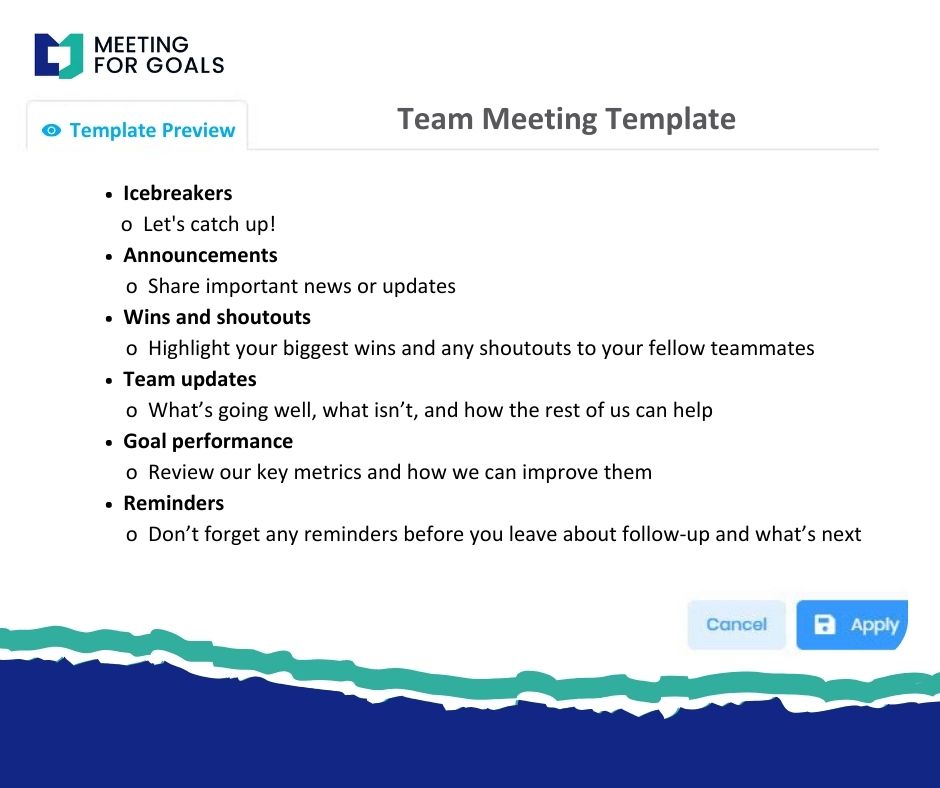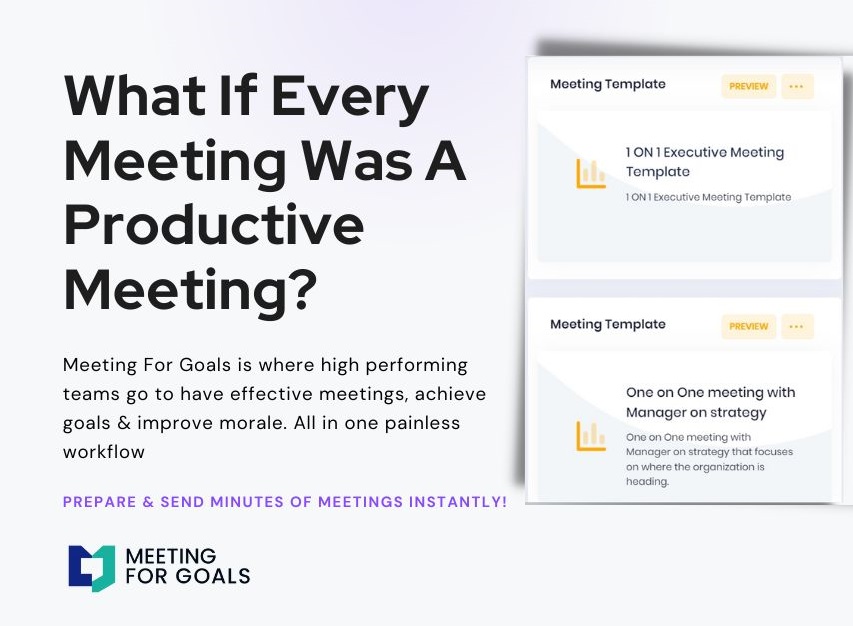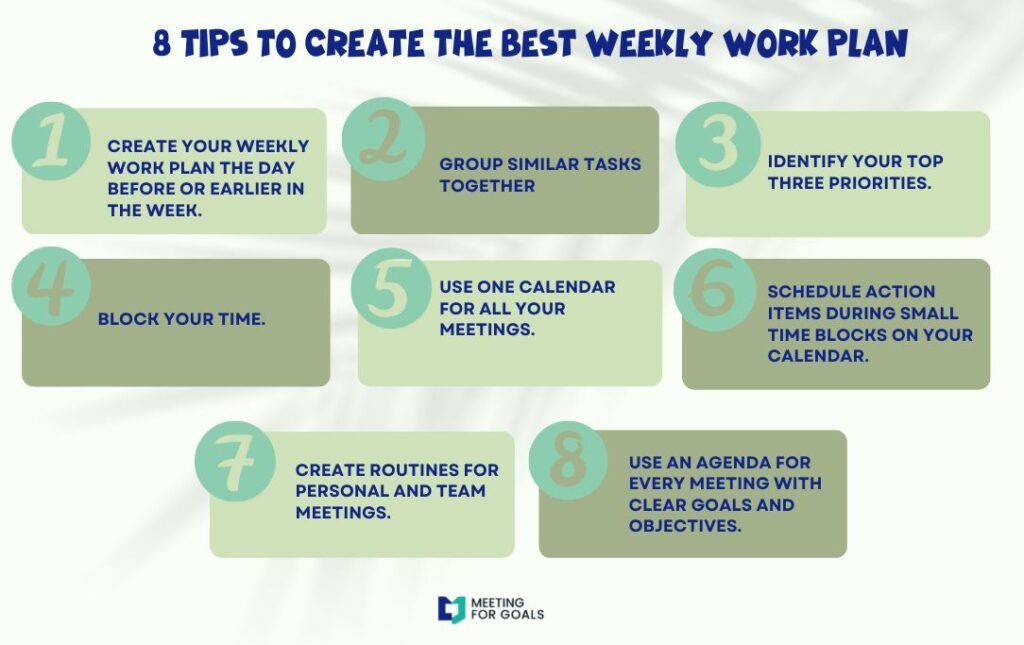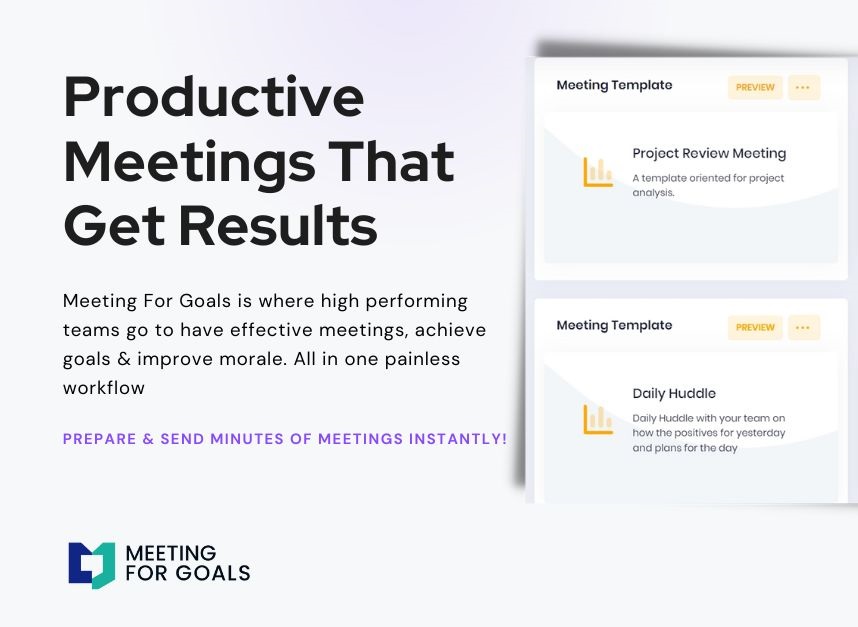Action Items for High-Performing Meetings
Excerpt:
In today’s fast-paced business environment, the difference between a high-performing team and a struggling one often comes down to how effectively they meet. Meetings should be a launchpad for productivity—not a drain on time and morale. Yet, too often, they become just that. At Meeting For Goals, we believe that structured, purposeful meetings are the key to driving results, aligning teams, and reaching company objectives. In this blog, we’ll explore essential action items that can transform your meetings into powerful tools for success. Whether you’re a VP, Director, or C-suite executive leading a 40–70 person team, these strategies will help you make every meeting count.
Start improving your meetings today with our free meeting templates: https://meetingforgoals.com/meeting_templates
Or sign up now to build a meeting culture that drives results: https://app.meetingforgoals.com/TenantRegistration/Register
I. Introduction
Meetings are a regular part of business life—but not all meetings are effective. In fact, research from Harvard Business Review shows that 71% of managers feel meetings are unproductive and inefficient. That’s a lot of wasted time and energy, especially for high-performing teams that need to stay aligned and agile.
At Meeting For Goals, we’re on a mission to fix that. Our platform helps teams run shorter, smarter meetings that stay connected to company goals. We’re here to help you save time, increase accountability, and build a culture of execution.
This guide is for leaders—Directors, VPs, and C-level executives—who want to improve how their teams meet. If you’re managing 40 to 70 employees, these strategies can help you turn every meeting into a high-impact session that drives results.
Let’s dive into the six core action items that will transform your meetings from time-wasters into productivity powerhouses.
2 Minute Video
Watch a 2 minute demo of our meeting management software in action
II. Establish Clear Objectives and Goals
Let’s be honest—how many times have you sat through a meeting and thought, “Why are we even here?” That’s what happens when meetings don’t have clear goals.
Meetings without a defined purpose often drift off course. People tune out. Time is wasted. And worst of all, nothing gets done.
Why Objectives Matter
Setting clear objectives gives your meeting direction. Everyone knows what the meeting is about, what needs to be accomplished, and how their input fits into the bigger picture. This clarity keeps everyone focused and engaged.
When objectives are vague, meetings tend to spiral. You lose momentum, and your team walks away confused instead of empowered.
Aligning Meetings with Company Goals
Every meeting should serve a purpose that ties back to your company’s broader goals. Before scheduling a meeting, ask yourself:
- Does this meeting support our quarterly or annual objectives?
- What decisions or actions need to come out of this?
- Who absolutely needs to be in the room?
Using the SMART framework —Specific, Measurable, Achievable, Relevant, and Time-bound—can help. For example, instead of saying, “Review Q3 marketing,” try: “Finalize Q3 marketing strategy with input from sales and product teams by end of meeting.”
This makes the goal tangible and actionable.
Involving the Team
Don’t keep goal-setting top-down. Invite your team to help shape meeting objectives. This builds buy-in and ensures the agenda reflects real-time needs.
Ask team members to suggest agenda items that align with the meeting’s purpose. This collaborative approach encourages ownership and ensures the meeting is relevant to everyone in the room.
Prioritizing Agenda Topics
Once you’ve set your objective, choose 2–3 high-impact topics to focus on. Don’t try to cram everything into one meeting. Less is more.
For a 60-minute meeting, limit yourself to three major topics. Give each enough time for meaningful discussion and decision-making.
Bottom line: Start every meeting with a clear, SMART objective. Align it with your company’s goals. Get your team involved. Focus on what matters most.
Adding an Agenda
How to add an agenda instantly on Meeting For Goals
III. Develop a Structured Agenda
Think of a meeting agenda like a GPS. Without it, you’re just driving around aimlessly. With it, you know where you’re going, how long it’ll take, and what turns to make along the way.
A structured agenda keeps meetings focused, efficient, and on track.
Components of an Effective Agenda
Here’s what a great agenda should include:
- A clear meeting objective
- A prioritized list of discussion topics
- Time estimates for each topic
- A designated owner for each item
- Expected outcomes or decisions
This structure helps everyone come prepared and stay engaged.
Keeping the Agenda Focused
Avoid turning your meeting into a status update. That’s what emails and project tools are for. Meetings should be reserved for collaboration, decision-making, and problem-solving.
Stick to 3–5 key topics. Any more, and you risk running out of time or rushing through important items.
Timeboxing for Accountability
Timeboxing means assigning a set amount of time to each agenda item. It helps prevent one topic from hijacking the whole meeting.
If a discussion runs long, the facilitator can decide to table it for later or schedule a follow-up. This keeps the meeting moving and respects everyone’s time.
Using Meeting For Goals to Build Agendas
Our platform makes it easy to create structured agendas. With built-in templates and drag-and-drop tools, you can build a professional agenda in minutes.
Assign owners, set time limits, and define outcomes—all in one place. Then share it with your team ahead of time, so everyone comes prepared.
Want to see how easy it is? Check out our free meeting templates here.
In short, a structured agenda is essential. It keeps your team aligned, your meeting on track, and your outcomes measurable.
IV. Assign Roles and Responsibilities
Ever been in a meeting where everyone talks over each other, no one takes notes, and nothing gets followed up on? That’s what happens when roles aren’t assigned.
Assigning roles adds structure and accountability to your meetings.
Why Roles Matter
When people know their role, they know what’s expected of them. This boosts engagement and ensures that all parts of the meeting run smoothly.
It also prevents multitasking and helps everyone stay focused on their contribution.
Common Meeting Roles
Here are three key roles every meeting should have:
- Facilitator – Keeps the meeting on track, guides the discussion, and ensures everyone has a voice.
- Note-Taker – Captures key points, decisions, and action items.
- Timekeeper – Keeps an eye on the clock and ensures each topic sticks to its time limit.
Depending on the meeting, you might also assign a Decision-Maker or Subject Matter Expert.
Encouraging Role Rotation
Don’t let the same people take on these roles every time. Rotate them across your team. This builds skills and keeps everyone engaged.
Let a junior team member facilitate a meeting—it’s a great leadership development opportunity.
Driving Accountability Through Roles
When roles are clearly defined, it’s easier to follow through. For example, if the note-taker records that “Sarah will deliver the client proposal by Friday,” then there’s no confusion about who’s responsible.
Meeting For Goals lets you assign roles directly in the meeting interface. Everyone can see who’s doing what—during and after the meeting.
Assigning roles may seem simple, but it’s a game-changer. It brings order to your meetings and helps turn talk into action.
V. Utilize Action Item Tracking Tools
A meeting isn’t successful because people talked a lot. It’s successful when things get done afterward.
That’s why tracking action items is critical.
Why Action Item Tracking Matters
Without a tracking system, important decisions and tasks get lost. Deadlines slip. Teams get frustrated. And the same issues keep coming up again and again.
High-performing teams don’t let that happen. They treat action items as commitments.
Leveraging Technology for Tracking
Using a tool like Meeting For Goals makes it easy to track action items in real-time. During the meeting, you can:
- Assign tasks to specific people
- Set deadlines
- Link tasks to goals or KPIs
After the meeting, these tasks stay visible and accessible. No more post-meeting confusion or forgotten follow-ups.
Best Practices for Effective Tracking
- Be Clear – Write action items that are specific and actionable. “Send Q3 report to CFO by Wednesday” is better than “Follow up on Q3.”
- Assign Ownership – Every task needs a single owner. No shared responsibility.
- Set Deadlines – A task without a due date is just a suggestion.
- Review Progress – Start each meeting by checking in on last week’s action items.
- Centralize Everything – Keep all your meeting notes and tasks in one place.
Want to see how this works in action? Sign up and try it today: https://app.meetingforgoals.com/TenantRegistration/Register
Tracking action items turns your meetings into engines of execution. It’s not just about talking—it’s about doing.
VI. Use Data to Continuously Improve Meetings
Great teams don’t just run good meetings—they continuously improve them.
That’s where data comes in.
Why Metrics Matter
Tracking meeting data helps you identify what’s working and what’s not. Are meetings too long? Are certain topics always running over? Are action items getting completed?
With the right insights, you can make small tweaks that lead to big improvements.
What to Measure
Here are some key metrics to track:
- Meeting duration vs. planned time
- Number of action items completed
- Attendance and engagement levels
- Time spent per agenda item
- Recurring issues or blockers
Tools like Meeting For Goals automatically track these metrics for you. You can view trends over time and make data-driven decisions about how to improve.
For example, if you notice that most meetings go 20 minutes over, you might need to tighten your agenda or improve timeboxing.
Learning from Feedback
Don’t forget qualitative feedback. Ask your team what’s working and what’s not. Use short post-meeting surveys or quick check-ins.
This feedback loop helps you build a meeting culture that evolves and improves.
Want to learn more about meeting analytics? This article from McKinsey offers great insights into how data can improve team performance: https://www.mckinsey.com/capabilities/people-and-organizational-performance/our-insights/the-organization-blog/how-to-run-better-meetings
VII. Conclusion
High-performing meetings don’t happen by chance. They happen because leaders like you take the time to plan, structure, and follow through.
Here’s a quick recap:
- Start with clear, SMART objectives
- Build a focused, time-boxed agenda
- Assign roles to keep things organized
- Track action items to drive execution
- Use data to continuously improve
At Meeting For Goals, we’re here to help you make every meeting count. Our platform is built to support these best practices—so you can save time, boost accountability, and hit your goals faster.
Ready to take your meetings to the next level? Sign up today: https://app.meetingforgoals.com/TenantRegistration/Register
Or explore our free meeting templates to get started: https://meetingforgoals.com/meeting_templates
Let’s make meetings matter. Visit us at https://meetingforgoals.com and start building a high-performance meeting culture today.




